Garandō in September
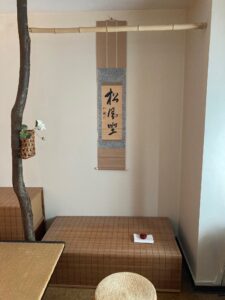
Ga-ran-dō, 伽蘭洞, Attend-orchid-cave. Toko-no-ma, 床の間, floor-’s-room, kake-jiku, 掛軸, hang-scroll, calligraphy, Shō-fu-za, 松風座, Pine-wind-sit, signed, jo-kyō, 如郷, like-home; kake-hana-ire, 掛花入, hang-flower-enter, bamboo kago, 籠, basket; kō-gō, 香合, incense-gather, red-lacquered, round, covered container with gold design of kiku, 菊, chrysanthemum, displayed on kami-kama-shiki, 紙釜敷, paper kettle-spread.

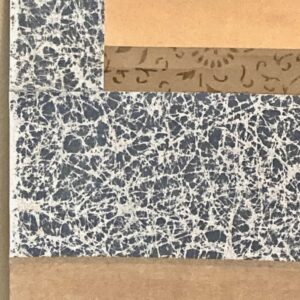
Kakejiku mounting hyō-gu, 表具, front-tools. Hon-shi, 本紙, origin-paper, has yellowed greatly. Ichi-mon-ji, 一文字, one-letter-character, brown paper with printed floral design in oxidized gold paint. Chū-mawashi, 中廻, mid-surround, white paper with gray paint, crinkled and flattened to produce myriad cracks called momi-gami, 揉み紙, crumpled-paper. The lower area of the scroll called chi, 地, earth, russet brown paper. The same paper is in the upper area of ten, 天, heaven, not shown.
The momi–gami was created to emulate the paper jackets worn by Buddhist priests, which, after years of repeated wearing and folding, were discarded. These crumpled paper jackets were subsequently used in mounting kakejiku, because they were imbued with revered Buddhist spirit.
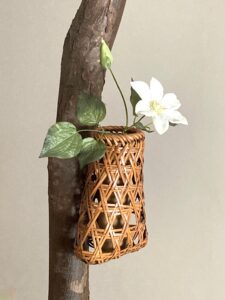
The hanaire is loosely based on a basket that a mountaineer would use to carry a nata, 鉈, a sturdy broad-bladed knife. This tool may be slightly curved, and used like a hatchet in woodcraft and hunting. This type of basket flower vase was created for Sen no Rikyū. Because of its rounded bottom, the basket cannot stand upright, and can only hang. The toko–bashira, 床柱, floor-post, is katsura, 桂, also known as cinnamon bark tree.
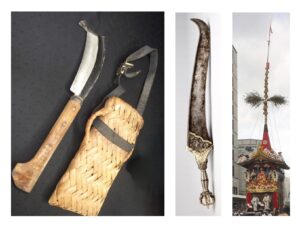
Left: nata/knife and saya/sheath, the blade would be protected in the sheath. Center: Vajra flaying knife; curved blade with go-ko-sho, 五鈷杵, five-cobalt-pestle, Tibet, 15th century; Buddhist weapon against evil. Right: Nagi-nata boko, 長刀鉾, long-sword-halberd, a mobile shrine in the parade of the Gi-on Matsuri, 祇園祭, God-garden Festival, in July in Kyōto. The Kanji for the Gion nata, 刀, may have originally been, 鉈, as it is used as such elsewhere.
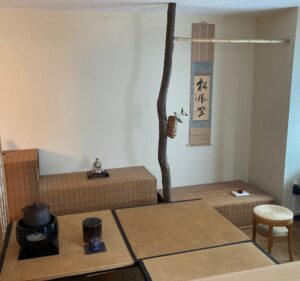
Ga-ran-dō, 伽蘭洞, Attend-orchid-cave, prepared for the presentation of Wa-kin Date, 和巾点, Harmony (Japan)-cloth-offer. Cha-dō-gu, 茶道具, tea-way-tools, presented here are:
Mayu bu-ro, 眉風炉, eyebrow wind-hearth, with ovoid hi-mado, 火窓, fire-window, black-lacquered, shin kuro, 真黒, true-black, (this furo is also classified as a do-bu-ro, 土風炉, earth-wind-hearth) by Yama-moto Sō-un, 山本崇雲, Mountain-origin Revere-cloud. Choice of Sen Rikyū.
Kata-tsuki kama, 肩付釜, shoulder-thrust-kettle, brown patinated tetsu, 鉄, iron, with raised design of shira-sagi, 白鷺, white-egret, by Taka-hashi Kei-ten, 高橋敬典, High-bridge Respect-rule, Yama-gata, 山形, Mountain-shape who has been designated as a National-treasure, Nin-gen Koku-hō, 人間国宝, Person-space Country-treasure. The kama is supported in the furo on a trivet called a go-toku, 五徳, five-virtues.
Mizu-sashi, 水指, water-indicate, hito-e-guchi, 一重口, one-layer-opening, Ko-se-to, 古瀬戸, Old-rapids-gate, by Ka-tō Tō-zan, 加藤藤山, Addition-wisteria Wisteria-mountain, Izumi-gama, 泉窯, spring-kiln, Se-to, 瀬戸, Rapids-gate. With black-lacquered lid.
Cha-ki, 茶器, tea-container, cylindrical turned wood naka-tsuki, 中付, mid-join, covered with a drawstring silk shi-fuku, 仕覆, serve-cover, with pattern of Hana-usagi kin-ran, 花兎金襴, Flower-hare gold-brocade, displayed on a matching ko-buku-sa, 古帛紗, old-cloth-gauze, which is the featured utensil, having a special association.
The Wakin Date is for the presentation of koi-cha, 濃茶, thick-tea. It is necessary to use a chawan that is Raku-yaki, 楽焼, Pleasure-fired, as it does not require the use of a ko-buku-sa, 古帛紗, old-cloth-gauze. The use of a second kobukusa would detract from the importance of the Wakin kobukusa.

Utensils for Wa-kin Date, 和巾点, Harmony (Japan)-cloth. From left: shi-fuku, 仕覆, serve-cover, with pattern of Hana-usagi kin-ran, 花兎金襴, Flower-hare gold brocade; kuwa naka-tsuki, 桑中付, mulberry middle-join, tea container with lid removed, and showing gold leaf interior, placed on ‘Wakin’ kobukusa; lid placed on kobukusa. When the guest looks at the utensils, hai-ken, 拝見, respectful-looking, her or his own kobukusa is used to place the chaki when examining the Wakin kobukusa.
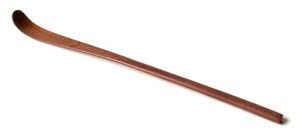
According to Urasenke traditions, for most Tea presentations the preferred chashaku is made of take, 竹, bamboo. The prime reason is that the chashaku can be crafted by a Buddhist priest, thereby bestowing the scoop with Buddhist spirit, Zen spirit, and a go-mei, ご銘, hon.-name. There are many instances when the bamboo chashaku is made by an artisan, and chosen by the priest in accord with personal preferences. Chashaku made of ivory, zō-ge, 象牙, elephant-tooth, or wood, glass, tortoise shell, silver, gold, etc., do not usually have a gomei.
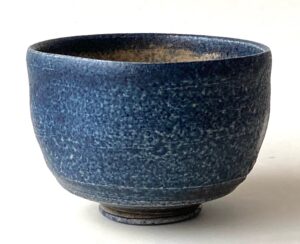
In Buddhism, it is written that the Shi-ten-no, 四天王, Four-heaven-kings, assembled to praise the Buddha, and each of the kings gave a bowl to the Buddha. The Buddha transformed the four bowls into one bowl, which became lapis lazuli, ru-ri, 瑠璃, gemstone-lapis lazuli. The word lapis is from Latin for stone, and lazuli from Persian meaning heaven for its deep blue color: stone heaven. Ruri is one of the seven precious gemstones of Buddhism. The Buddhist deity, Yaku-shi Nyo-rai, 薬師如来, Medicine-master Like-become, is the color of lapis lazuli.
Wakin Date does not utilize a display stand, tana, 棚, shelf, so that the futa-oki, 蓋置, lid-place, is made of ao-dake, 青竹, green-bamboo. This manner of Tea preparation is also presented with the ro, sunken hearth.
For further study, see also: Tea in September, Kobukusa, Kobuksa and Mandala Part 1, and Kobukusa and Mandala Part 2

